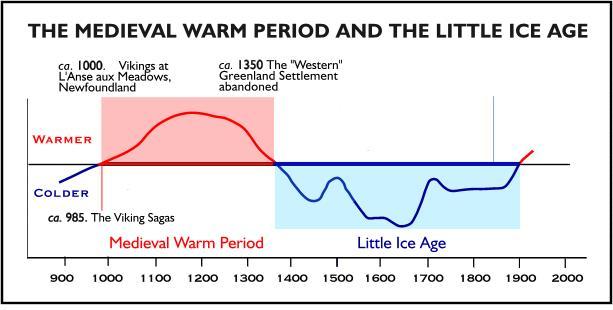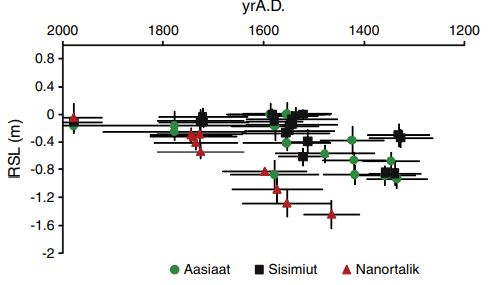On the 29/03/2019 I attended a Hutton Club talk was Dr Leanne Wake about calculating the sea-level history for Greenland over the Little Ice Age to present day. Until recently there has been little proxy records for Greenland making it very difficult to reconstruct the sea-level history for Greenland. However, Wake has started to gather cores from salt marshes and isolated basins to be able to reconstruct the sea-level change.
What was the Medieval Warm period and Little Ice Age?
Firstly, there was the Medieval Warm period from 950-1250 AD which caused warming in Europe of an increase of 0.3-0.4°C while Greenland actually reduced in temperature by 2°C. Then there was the Little Ice Age that took place afterwards with a cooling period in Europe and continuing in Greenland. Previous studies of ice cores have highlighted that Greenland had a decrease in temperature from 900 to 1500 AD and then the temperature began to increase again. Not many studies have been conducted to understand the changes in sea-level over this period and so Wake has tried to reconstruct the sea-level over this period.

How can salt marshes be useful?
Cores taken from salt marshes were used to work out the ‘finger print’ of the sea-level history. These cores are able to highlight a change in sediment colours that highlighted a transition from a marine environment (grey sediment) to fresh water (light brown sediment). These cores can then be dated using radiocarbon δ13C and the different layers were investigated looking at thickness and sediment composition. These techniques allow understanding of when these sea-level changes occurred and then link these changes to alterations in ice sheet temperature.

Salt mashes in Greenland
Wake tested this technique by taking cores from four coastal sites on the west coast of Greenland. Wake also took samples from isolated basins to look at the soil layers to further look at sea-level change. However, the soil layers from isolated basins had poor preservation and so the salt marshes were the most useful. The data taken from cores was used along with a sea-level model calculated for Greenland.
It has been found from the results that as the sea-level fluctuates through the Little Age Age. From 1300-1600 AD there was a rise in relative sea-level at these sites which is expected in the cooler temperatures during this period. However, from 1600 AD on wards there was a period of slowdown and stabilising of relative sea-level. The change in sea-level from 1600 AD was not expected as during this time Greenland was thought to still be in a cooler temperature in the Little Ice Age. Wake proposed that change could be the result a reduction in precipitation and higher air temperatures at Southwest Greenland.

Using Earth Observation to estimate recent changes
Wake then goes on to discuss her other research project related to sea-level in Greenland. Aerial photographs a glacier from 1932 and 1985 found in the centre of Greenland have been used to measure changes in glacier size in Greenland using GIS. These changes were then compared to global mass change in glaciers from 1901 to 1985 (Marzeion et al, 2015) and salt marsh cores. The results highlighted that were was a sea-level rise during this period. However, the data does not show and expected peak in sea-level during this period sea-levels with the results being 60cm less than what had been calculated previously. More work needs to be done around this subject to try to understand why the sea-level is lower than what was expected from 1905 to 1985.
This talk by Wake was interesting for pointing out advances in sea-level research techniques on Greenland and the first half of the talk was easy to follow. The second part of the talk become more confusing for a Friday afternoon. I think that this research is important as it is important to understand how changes in temperature effect glaciers and sea-level as by understanding past changes we can use this knowledge to predict future sea-level changes.
Further reading:
Long et al., 2011. Relative sea-level change in Greenland during the last 700 yrs and ice sheet response to the Little Ice Age. Earth and Planetary Science Letters, 315-316(C), pp.76–85.
Marzeion, B., Leclercq, P., Cogley, J and Jarosch, A., 2015. Brief Communication: Global reconstructions of glacier mass change during the 20th century are consistent. The Cryosphere, 9(6), pp.2399–2404.